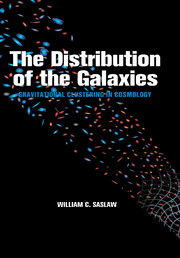Book contents
- Frontmatter
- Contents
- Prologue
- Part I Historical
- Part II Descriptions of Clustering
- 8 Patterns and Illusions
- 9 Percolation
- 10 Minimal Spanning Trees
- 11 Topology
- 12 Fractals
- 13 Bound Clusters
- 14 Correlation Functions
- 15 Distribution Functions
- Part III Gravity and Correlation Functions
- Part IV Gravity and Distribution Functions
- Part V Computer Experiments for Distribution Functions
- Part VI Observations of Distribution Functions
- Part VII Future Unfoldings
- Bibliography
- Index
12 - Fractals
Published online by Cambridge University Press: 19 January 2010
- Frontmatter
- Contents
- Prologue
- Part I Historical
- Part II Descriptions of Clustering
- 8 Patterns and Illusions
- 9 Percolation
- 10 Minimal Spanning Trees
- 11 Topology
- 12 Fractals
- 13 Bound Clusters
- 14 Correlation Functions
- 15 Distribution Functions
- Part III Gravity and Correlation Functions
- Part IV Gravity and Distribution Functions
- Part V Computer Experiments for Distribution Functions
- Part VI Observations of Distribution Functions
- Part VII Future Unfoldings
- Bibliography
- Index
Summary
All, all of a piece throughout.
DrydenFractals help characterize the scaling properties of point distributions. Originally astronomers hoped that the galaxy distribution would have simple scaling properties following from the scale-free form of the gravitational potential. It was not to be. Nevertheless, fractals provide useful insights that can be related to correlation and distribution functions.
The main fractal measure of a set of points is its “dimension.” A continuous set of points, such as a line, plane, or spherical ball has an integral topological dimension whose definition goes back at least to Euclid. It refers to the number of independent coordinates needed to locate a point in this set. When Cantor (1883) found his middle-thirds set, however, it became necessary to generalize the concept of dimension. Cantor's set has an uncountably infinite number of points, all disconnected from each other so that there is no continuous interval in the set, even though each point has another which is arbitrarily close. It is simple to construct (Figure 12.1). Start with the unit interval [0, 1] and successively delete the innermost third of each remaining line segment. Cantor's set, C, contains all the points common to the sequence of subsets C0, C1, C2, C3… This set is self-similar since expanding the scale of Cn+1 by a factor 3 gives, for each of the parts of Cn+1 that contains two lines, a shape identical with Cn.
- Type
- Chapter
- Information
- The Distribution of the GalaxiesGravitational Clustering in Cosmology, pp. 91 - 99Publisher: Cambridge University PressPrint publication year: 1999

